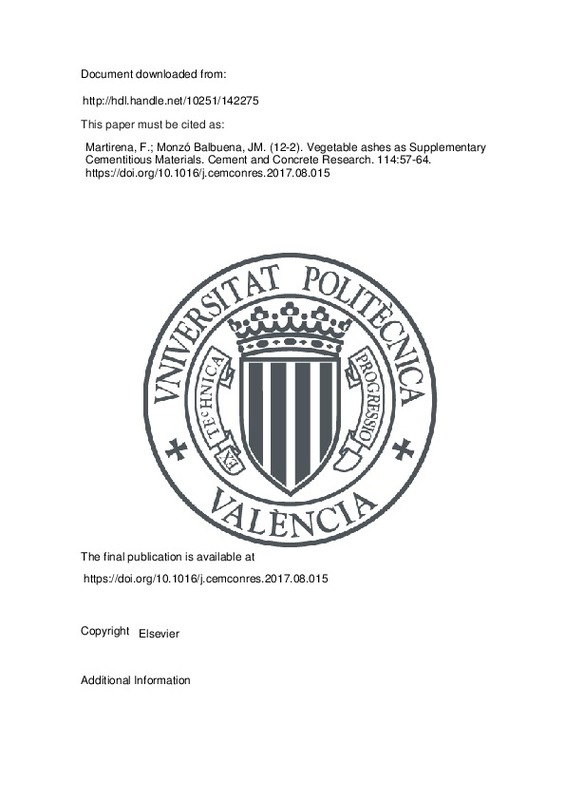JavaScript is disabled for your browser. Some features of this site may not work without it.
Buscar en RiuNet
Listar
Mi cuenta
Estadísticas
Ayuda RiuNet
Admin. UPV
Vegetable ashes as Supplementary Cementitious Materials
Mostrar el registro sencillo del ítem
Ficheros en el ítem
| dc.contributor.author | Martirena, F.
|
es_ES |
| dc.contributor.author | Monzó Balbuena, José Mª
|
es_ES |
| dc.date.accessioned | 2020-05-05T06:18:30Z | |
| dc.date.available | 2020-05-05T06:18:30Z | |
| dc.date.issued | 2018-12 | es_ES |
| dc.identifier.issn | 0008-8846 | es_ES |
| dc.identifier.uri | http://hdl.handle.net/10251/142275 | |
| dc.description.abstract | [EN] Approximately 140 billion metric tons of biomass are produced every year in the world from agriculture. The ashes resulting from firing agricultural wastes such as rice husk, sugar cane and others can be used as Supplementary Cementitious Materials (SCM). They can be mixed with lime alone or in ternary mixtures with Portland cement and lime. If fired at temperatures around 600-700 °C the agricultural ashes exhibit good reactivity. Despite extensive research work carried out on the use of agricultural ashes as source of SCMs, few success stories are reported on practical applications on an industrial scale. Details of the firing technology should be re-assessed, with special emphasis on the scale at which the technology begins to be economically suitable. Further research is also needed to understand the mechanisms of structural transformation of amorphous silica during calcination, and the impact of the ashes on cement hydration in blended systems. | es_ES |
| dc.language | Inglés | es_ES |
| dc.publisher | Elsevier | es_ES |
| dc.relation.ispartof | Cement and Concrete Research | es_ES |
| dc.rights | Reserva de todos los derechos | es_ES |
| dc.subject | Rice husk ash | es_ES |
| dc.subject | Pozzolanic activity | es_ES |
| dc.subject | Blended cement | es_ES |
| dc.subject | Straw ash | es_ES |
| dc.subject | Fly-ash | es_ES |
| dc.subject | Biomass | es_ES |
| dc.subject | Combustion | es_ES |
| dc.subject | Strenght | es_ES |
| dc.subject | Lime | es_ES |
| dc.subject | Gasification | es_ES |
| dc.subject.classification | INGENIERIA DE LA CONSTRUCCION | es_ES |
| dc.title | Vegetable ashes as Supplementary Cementitious Materials | es_ES |
| dc.type | Artículo | es_ES |
| dc.identifier.doi | 10.1016/j.cemconres.2017.08.015 | es_ES |
| dc.relation.projectID | info:eu-repo/grantAgreement/MINECO//BIA2015-70107-R/ES/APLICACIONES DE SISTEMAS GEOPOLIMERICOS OBTENIDOS A PARTIR DE MEZCLAS DE RESIDUOS: MORTEROS,HORMIGONES Y ESTABILIZACION DE SUELOS/ | es_ES |
| dc.rights.accessRights | Abierto | es_ES |
| dc.contributor.affiliation | Universitat Politècnica de València. Departamento de Ingeniería de la Construcción y de Proyectos de Ingeniería Civil - Departament d'Enginyeria de la Construcció i de Projectes d'Enginyeria Civil | es_ES |
| dc.description.bibliographicCitation | Martirena, F.; Monzó Balbuena, JM. (2018). Vegetable ashes as Supplementary Cementitious Materials. Cement and Concrete Research. 114:57-64. https://doi.org/10.1016/j.cemconres.2017.08.015 | es_ES |
| dc.description.accrualMethod | S | es_ES |
| dc.relation.publisherversion | https://doi.org/10.1016/j.cemconres.2017.08.015 | es_ES |
| dc.description.upvformatpinicio | 57 | es_ES |
| dc.description.upvformatpfin | 64 | es_ES |
| dc.type.version | info:eu-repo/semantics/publishedVersion | es_ES |
| dc.description.volume | 114 | es_ES |
| dc.relation.pasarela | S\408103 | es_ES |
| dc.contributor.funder | Ministerio de Economía y Empresa | es_ES |
| dc.subject.ods | 11.- Conseguir que las ciudades y los asentamientos humanos sean inclusivos, seguros, resilientes y sostenibles | es_ES |
| dc.subject.ods | 08.- Fomentar el crecimiento económico sostenido, inclusivo y sostenible, el empleo pleno y productivo, y el trabajo decente para todos | es_ES |







![[Cerrado]](/themes/UPV/images/candado.png)

